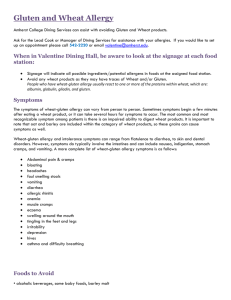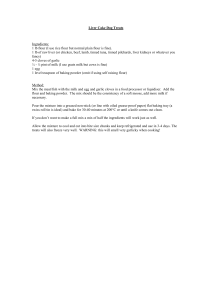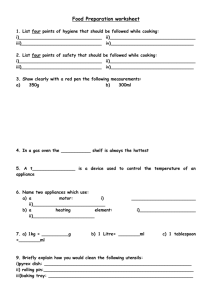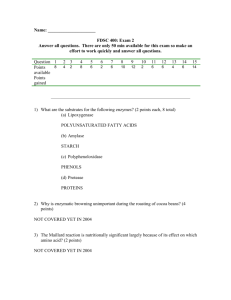261 18.12 Treatment of Flour from Damaged Wheat
advertisement
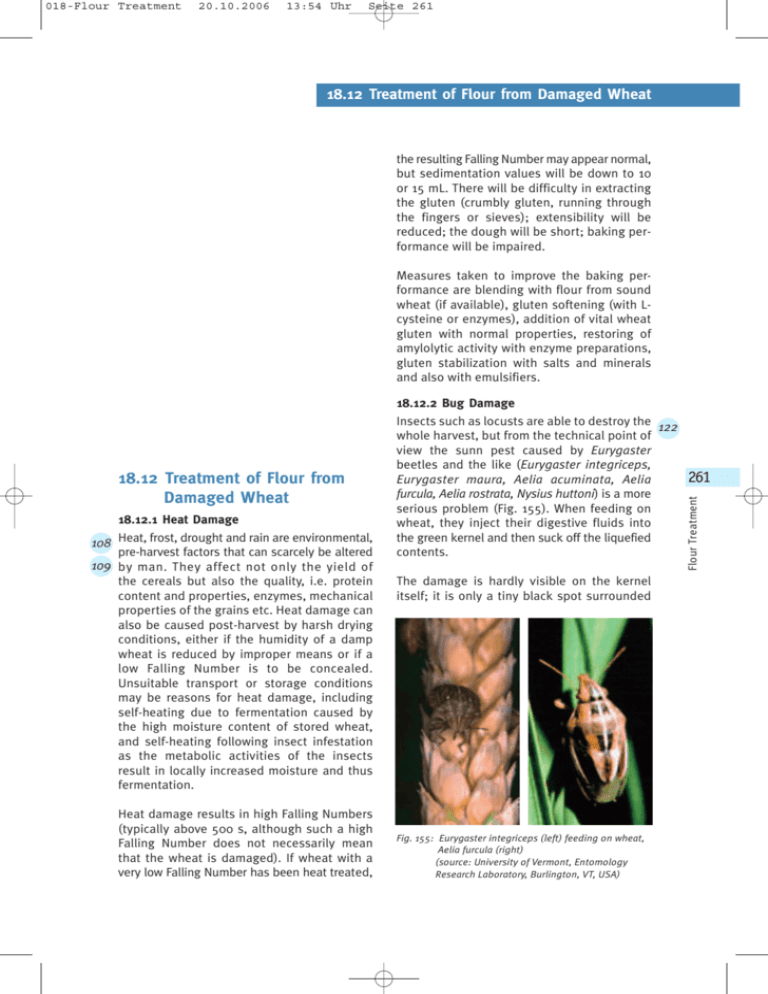
018-Flour Treatment 20.10.2006 13:54 Uhr Seite 261 18.12 Treatment of Flour from Damaged Wheat 18.12 Treatment of Flour from Damaged Wheat 18.12.1 Heat Damage 108 Heat, frost, drought and rain are environmental, pre-harvest factors that can scarcely be altered 109 by man. They affect not only the yield of the cereals but also the quality, i.e. protein content and properties, enzymes, mechanical properties of the grains etc. Heat damage can also be caused post-harvest by harsh drying conditions, either if the humidity of a damp wheat is reduced by improper means or if a low Falling Number is to be concealed. Unsuitable transport or storage conditions may be reasons for heat damage, including self-heating due to fermentation caused by the high moisture content of stored wheat, and self-heating following insect infestation as the metabolic activities of the insects result in locally increased moisture and thus fermentation. Heat damage results in high Falling Numbers (typically above 500 s, although such a high Falling Number does not necessarily mean that the wheat is damaged). If wheat with a very low Falling Number has been heat treated, the resulting Falling Number may appear normal, but sedimentation values will be down to 10 or 15 mL. There will be difficulty in extracting the gluten (crumbly gluten, running through the fingers or sieves); extensibility will be reduced; the dough will be short; baking performance will be impaired. Measures taken to improve the baking performance are blending with flour from sound wheat (if available), gluten softening (with Lcysteine or enzymes), addition of vital wheat gluten with normal properties, restoring of amylolytic activity with enzyme preparations, gluten stabilization with salts and minerals and also with emulsifiers. 18.12.2 Bug Damage Insects such as locusts are able to destroy the 122 whole harvest, but from the technical point of view the sunn pest caused by Eurygaster beetles and the like (Eurygaster integriceps, Eurygaster maura, Aelia acuminata, Aelia furcula, Aelia rostrata, Nysius huttoni) is a more serious problem (Fig. 155). When feeding on wheat, they inject their digestive fluids into the green kernel and then suck off the liquefied contents. The damage is hardly visible on the kernel itself; it is only a tiny black spot surrounded Fig. 155: Eurygaster integriceps (left) feeding on wheat, Aelia furcula (right) (source: University of Vermont, Entomology Research Laboratory, Burlington, VT, USA) 261 Flour Treatment for specific applications such as deep frozen dough to absorb water released from cold damaged protein or starch. As we mentioned earlier, bread with a higher water content keeps its softness longer. But there are limits: in some countries the moisture content of bread is restricted, and according to Kulp (1979) there is also an optimum level of water for long-lasting freshness. Guar gum, locust bean gum, pre-gelatinized waxy starches (rich in amylopectin) and cellulose derivatives such as carboxymethyl cellulose have already been in use for some decades. Pectin, agar agar and alginates, and also hydrocolloids from microbial sources such as xanthan, dextran, curdlan, or gellan have some promising properties too, but they are not used in flour mostly for cost reasons, since their performance/price ratios are lower than those of the thickening agents mentioned above. 018-Flour Treatment 20.10.2006 13:54 Uhr Seite 262 18.12 Treatment of Flour from Damaged Wheat by a zone of lighter colour. The weight of the kernels is almost unchanged; shrinkage sometimes occurs, but not necessarily. The gluten index will be lower, but still close to normal; the Swelling Index ("G" in the Alveograph) is lower; extracted gluten liquefies upon resting; in the Farinograph, the dough shows very low stability and a narrow curve; the dough is sticky and runny with low resistance; of course the baking performance will be impaired; if the damage is very heavy, even a bitter taste may occur. Flour Treatment 262 The enzymes in the insect's saliva are mainly of a proteolytic nature (no amylase reported so far). Bug damage therefore results in flour with extremely soft gluten and a quality that is poor to useless for bread baking. The bitterness is caused by small protein fragments (peptides) resulting from protein hydrolysis by the enzymes. Fig. 156 compares a dough made from bug-damaged flour with a dough to which bacterial protease had been added. The insect enzymes seem to be very effective in causing gluten degradation. As little as one percent of damaged kernels can make a wheat flour unsuitable for bread making. Recommendations for improving bug-damaged wheat include conditioning at increased moisture and temperature in order to destroy the insect enzymes. But it appears rather difficult to selectively denaturize the insect proteins without degrading the wheat protein as well. Blending with sound flour is another option, but the damaged part must be minimized. The baker can improve the situation by reducing the dough resting times to a minimum, which gives the enzymes less time to act on the gluten. Furthermore, the miller or the baker can use improvers that strengthen the gluten (ascorbic acid, enzymes, phosphates), block the insect enzymes (acidic or alkaline buffers, specific inhibitors), or improve the overall baking properties (emulsifiers, vital wheat gluten). There are also applications in which the bug-damaged wheat can be used as it is, e.g. as flour for biscuits, crackers or wafers. 18.12.3 Sprout Damage The term sprout damage describes a condition 106 caused by high humidity prior to harvest: instead of falling into their winter rest, the kernels start the growth cycle again. In order to activate the energy stored in the form of starch, the synthesis of amylolytic enzymes is one of the first actions of the awakening kernel. The enzymes can have dramatic effects on flour properties, depending on the severity of the sprout damage and thus the amount of enzymes formed. Falling Numbers, gelatinization temperature and maximum Amylograph viscosity will be lower, insufficient water Bacterial protease for biscuits & crackers Alphamalt BK 5020 50 g/100 kg Flour from incect damaged wheat Lebanon 1998 Fig. 156: Farinogram with flour from bug-damaged wheat (left) and from wheat flour with bacterial protease (right) 018-Flour Treatment 20.10.2006 13:54 Uhr Seite 263 18.12 Treatment of Flour from Damaged Wheat There are other causes of high amylase activity in grain: (a) frost on immature heads can result in increased residual levels of "green amylase", an enzyme that builds up during grain filling and disappears when the germination-type amylase is synthesized; and (b) late-maturity α-amylase (LMA), a genetic defect of some varieties which lack the ability to degrade the "green amylase" (Wrigley, 2004). The miller can counteract the effects of sprout damage with lower extraction rates (higher enzyme concentrations in the aleuron layer) and by keeping the starch damage as low as possible (the amylase can only act on damaged starch). The baker should increase the acidity with sour dough or acidifiers, prepare stiffer doughs, reduce the energy input during kneading, reduce the bench time (but increase the final proof ), reduce the dosage of bread improvers with strong enzyme activity and slightly increase the amount of salt (sodium chloride) if possible. In many cases, sprout-damaged flours require larger amounts of ascorbic acid. Emulsifiers and vital wheat gluten improve the dough stability, as usual. Enzyme preparations should be used with care. Some fungal amylase can still be added, but it should be reduced as compared to sound wheat flour; hemicellulases can be used, but since the doughs from sprouted wheat flour tend to be softer, their dosage should also be lower. In addition to these general recommendations, pH-buffering salt compounds can be used to shift the pH away from the optimum of the cereal enzymes and improve the water absorption of the flour components. Fig. 136 shows the effect of an alkaline buffering agent on Falling Numbers and on baking volume yield. Although larger amounts of the additive increase the Falling Number further, there is a distinct optimum for the baking volume beyond which the volume decreases again. The same additive also has a clear effect on gelatinization, as the Amylogram shows (Fig. 157). 18.12.4 Ropiness Very small organisms are responsible for 92 ropiness. The culprit, Bacillus mesentericus, the potato bacillus – a close relative of 97 Bacillus subtilis, the hay bacillus – occurs almost everywhere. It is present on the field Dosage (g/100 kg) Flour sample 9668 FN (s) AG (AU) AG (°C) 0 230 185 74.4 50 256 230 75.0 100 270 300 75.9 150 284 400 77.4 200 301 530 78.6 Fig. 157: Effect of Rowelit, an alkaline buffering agent, on the Amylogram (from bottom to top: 0, 50, 100, 150 and 200 g per 100 kg flour) 263 Flour Treatment absorption may be observed as well as sticky doughs, a weak dough structure, excessive browning and a coarse pore structure. Furthermore, the crumb structure has lower elasticity. On the other hand the baked goods tend to have a better taste, and the shelf-life (crumb softness) is also improved. 018-Flour Treatment 20.10.2006 13:54 Uhr Seite 264 18.13 Flour Treatment for Specific Applications Flour Treatment 264 and thus on the wheat, but it may also thrive on flour residues on the walls of the bakery or on the equipment. When it finds its way into the dough it survives baking and destroys the crumb during storage of the bread. Warm, damp conditions promote the development of the micro-organisms, so its appearance is more frequent in summer. The dough shows normal baking properties and the fresh bread has a normal appearance. But within a short time a fruity flavour develops in the bread, turns into sweet smell and finally becomes disgusting. Meanwhile, degradation of the bread crumb takes place, along with a yellowish-brownish discoloration. When the bread is broken, thin slimy strands are formed (Fig. 158). mesentericus in the dough, for instance with sour dough or edible acids. Antimicrobial substances such as acetic or propionic acid and their salts (acetates and propionates) are also very effective in suppressing the growth of the organisms. Their effect is improved at lower pH values, i.e. in the presence of other acidifying agents. Since they affect taste and yeast growth, their dosage should be limited to a required minimum. The lack of volume yield caused by the antimicrobial agents can be compensated for by increased yeast levels and with flour additives such as enzymes or emulsifiers. The optimum growth conditions for B. mesentericus are 37 °C and pH 6. But it can grow in the range of 10 - 45 °C and a pH of 4.9 - 9.3. At 97 °C only 90% of the spores are inactivated within 2 h, and this temperature is far higher than that reached in the bread crumb. 18.13.1 Steamed Bread Thorough cleaning of the wheat reduces the chance of the bacterium to get into the bread, because it only adheres to the surface of the kernels. The baker can reduce its survival by proper cleaning of the bakery and equipment. If ropiness has occurred, the bakery and equipment should be disinfected, e.g. by washing with vinegar solution. Acidification is a means of controlling the growth of Bacillus 18.13 Flour Treatment for Specific Applications Introduction Although they differ in details, steamed breads from various regions have several properties in common, for instance the lack of stabilization by a firm crust (in contrast to baked bread), a very fine crumb structure, and a mild, almost bland taste. This can be considered an advantage because of the absence of acrylamide and the possibility of combining the steamed bread with various fillings and dishes. Since little or no salt is normally used, the dough is very extensible, but the stability of the finished, steamed product is also reduced. This is a special challenge to additives such as enzymes, ascorbic acid and other flour improvers. In the laboratory, steamed bread can be prepared in the traditional way – in baskets placed on woks containing boiling water (Fig. 159), stainless steel pots placed on a fire or electric hotplate, or in stainless steel steam chambers (Fig. 160). For the following investigations a steam chamber was used. Fig. 158: Ropiness in wheat bread (Schünemann and Treu, 2002) Furthermore, flour with normal properties without any obvious quality problems was used. It fell into the flour quality range usual for steamed bread (Tab. 95).
